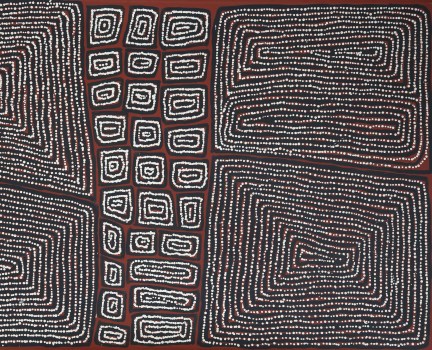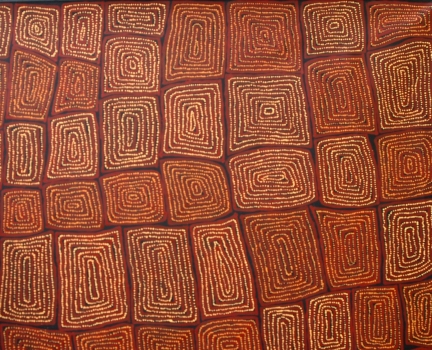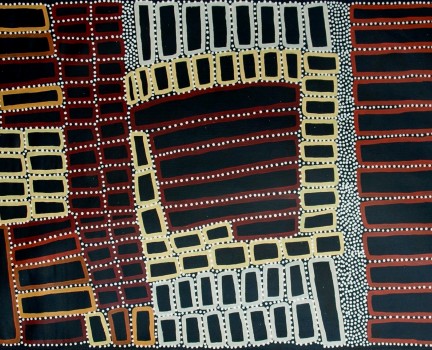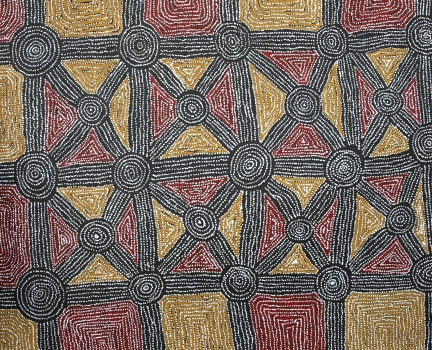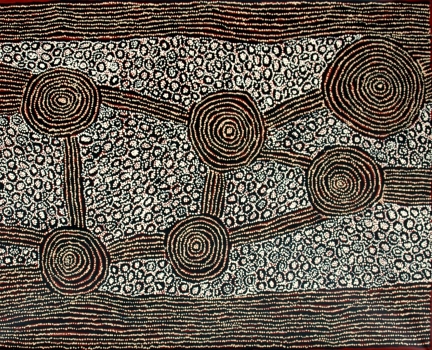Pintupi Dreaming Tingari
Tingari refers to the Dreaming and its Laws for the Pintupi language group of the Central Western Desert. The Tingari is the Creation era when the Dreamtime Ancestors moved across the lands, creating the features of the landscape and all aspects of the natural world.
The Tingari Ancestors stopped at specific sites on their journey, and the events that occurred at each site as they camped there, gave rise to all the features of the surrounding environment and the animals and plants that are found there. These Creation events have been embodied in the song cycles learned by initiated Pintupi elders, and these long narrative songs provide the Laws and social structures that traditional Pintupi people have lived under. As younger people are initiated into the Law, they are taken through gradual stages of knowledge of traditional matters, which becomes a life-long process.
The Tingari sites have traditional custodians, and these can be categorised into two groups - owners and managers. The owners’ role is to oversee and make sure that all aspects of maintenance of the site and its ceremonial obligations are properly carried out. The managers’ role is to organise the ceremonies to ensure that all aspects of the events are provided for and that the correct people are properly involved.
The custodial roles of the Tingari sites are handed down along family lines – they are tied to the kinship (skin) groups that are aligned to family groups. Often two skin groups will have custodial roles for a Tingari site, which further binds them together by their custodial obligations. The cohesion of traditional society is reinforced by the strong Laws and beliefs that are found in the Tingari song cycles.
Pintupi artists have painted representations of Tingari sites and Tingari Law as it applies to their country. Generally this has been created as an abstract series of structures and linear formations that show the power and the relationships of Tingari as it applies to the artists’ country. Tingari Law is considered both secret and sacred, so no aspects of the deeper meanings of Tingari Law are identified or elaborated on.
Artist brothers Warlimirrnga Tjapaltjarri, Walala Tjapaltjarri and Thomas Tjapaltjarri were part of the last group of nine family members who emerged from the Gibson Desert in 1984. They had stayed behind for about twenty years after other members of their clan had left their ancestral country. In the next few years after they left their homelands they began to paint aspect of desert culture associated with Tingari. At that time the Desert Art movement had been going for about fifteen years in the small settlements and communities where Aboriginal people lived on the outer perimeters of their traditional lands.
The Pintupi artists arrived at unique solutions to representing sacred cultural information in visual form. They had precedents from carving designs and sand paintings that referred to the great Tingari narratives. Walala Tjapaltjarri developed his style based around rectangular shapes that enclosed other motifs, like a keeping place for cultural ideas. These geometric shapes spread across the canvas, as though the culture spread broadly to all parts of the desert. Thomas Tjapaltjarri similarly used the rectangular shapes but often made them more organic, stretching and folding them to fit alongside each other and varying the relative sizes.
George Ward Tjungurrayi has created bands of lines across the canvas that show the journey lines of the Ancestors as they passed from one Creation site to another. He also used concentric circles to depict Tingari sites and highlights the linear structure with rows of dotting. The Pintupi artists became recognised for their abstract geometric structures that evoked the power and energy associated with the ancient Tingari stories that were the foundation of their culture.
Links
- Thomas Tjapaltjarri
- Dr George Ward Tjapaltjarri
- George Ward Tjungurrayi
- Walala Tjapaltjarri
- Patrick Tjungurrayi
- Ronnie Tjampitjinpa
Exhibitions
Back to Aboriginal Dreamtime Stories


